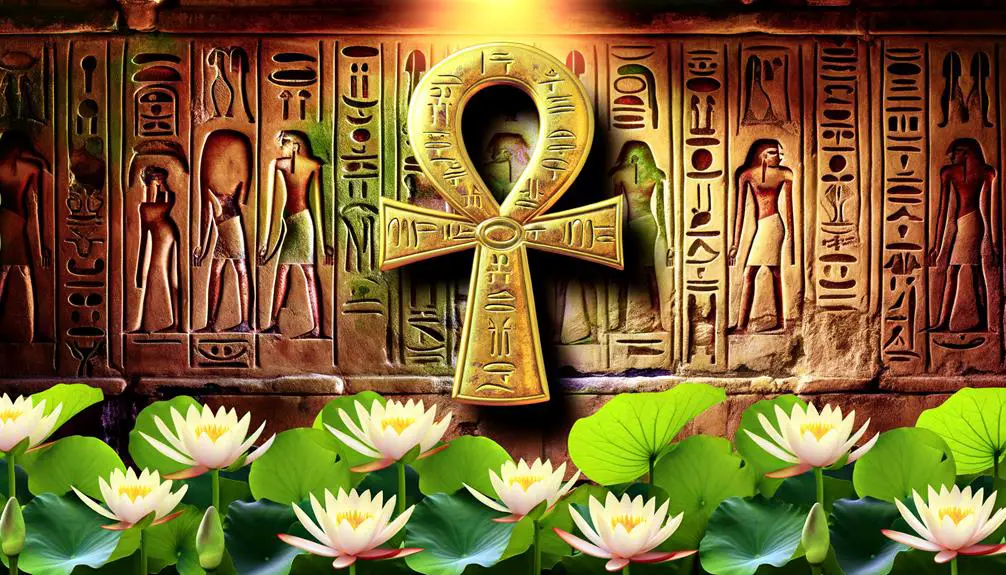Identifying and Interpreting Ancient Egyptian Symbols of Love
In ancient Egyptian culture, the Ankh is preeminent as a symbol of love, particularly divine love and the union of male and female principles representing fertility and regeneration. This iconic hieroglyph, resembling a cross with a loop at the top, emerged during the Early Dynastic Period around 3150 BCE.
Additionally, the goddess Hathor, with her associations to love, beauty, and motherhood, and the mythological relationship between Isis and Osiris exemplify eternal devotion and triumph over death. The symbolic use of the lotus flower for purity and rebirth further underscores the multifaceted representations of love in ancient Egyptian iconography.
Explore how these symbols interrelate in various cultural contexts.

Key Takeaways
- The Ankh represents eternal life and divine love in ancient Egyptian culture.
- Hathor, goddess of love and beauty, symbolizes themes of fertility, music, and joy.
- Isis and Osiris' story illustrates love, devotion, and triumph over death.
- The Lotus Flower signifies creation, rebirth, and purity linked to divine birth.
- Heart Scarabs, used in funerary customs, underscore the importance of truthful love and regeneration.
The Ankh

The Ankh, often referred to as the 'key of life,' is one of the most recognizable symbols of ancient Egyptian culture, representing both eternal life and divine love. This hieroglyphic character, resembling a cross with a loop at the top, was omnipresent in Egyptian art and inscriptions. Its origins trace back to the Early Dynastic Period, around 3150 BCE.
The Ankh's design is believed to symbolize the union of male and female principles, embodying the concept of fertility and regeneration. Deities and pharaohs are frequently depicted holding the Ankh, signifying their divine authority to bestow life and prosperity. As a potent emblem, the Ankh bridged the mortal and divine domains, underscoring its profound spiritual significance in ancient Egyptian society.
Hathor's Symbolism
Frequently revered as the goddess of love, beauty, and motherhood, Hathor's symbolism in ancient Egyptian culture is deeply intertwined with themes of fertility, music, and joy.
Hathor, often depicted with a cow's horns encircling a sun disk, represents the nourishing and life-giving aspects of femininity. Her associations extend to the celestial, as she was linked to the Milky Way, known as the Nile in the sky.
Temples dedicated to Hathor, such as the one in Dendera, highlight her importance in rituals of music and dance, symbolizing cosmic harmony.
Hathor's role as a divine mother underscores her protective nature, particularly towards women and children, further solidifying her as a multifaceted deity embodying love's nurturing essence.
Lotus Flower

Emerging as a potent symbol in ancient Egyptian iconography, the lotus flower epitomizes themes of creation, rebirth, and purity, deeply embedded within the religious and cultural fabric of the civilization.
The lotus, often observed closing at night and reopening with the daylight, symbolized the cyclical nature of life and the universe. It was inherently connected with the sun god Ra, representing his daily resurrection. This aquatic plant, flourishing in the Nile's fertile waters, also signified divine birth and spiritual enlightenment.
Depictions of the lotus are prevalent in art, religious texts, and temple decorations, underscoring its omnipresence and significance. Its association with fertility and renewal further underlines its role as a symbol of love and enduring life.
Isis and Osiris
Central to ancient Egyptian mythology, the tale of Isis and Osiris encapsulates themes of love, devotion, and the triumph of life over death. Osiris, revered as the god of the afterlife, was betrayed and dismembered by his brother Set.
In an act of profound love and determination, Isis, his wife and goddess of magic, meticulously gathered his body parts and used her divine powers to resurrect him. This act not only restored Osiris but also led to the birth of their son, Horus, symbolizing continuity and rebirth.
The myth of Isis and Osiris illustrates the enduring power of love and the belief in eternal life, deeply ingrained within the religious and cultural fabric of ancient Egypt.
Heart Scarab

The heart scarab, a funerary amulet shaped like the sacred beetle and inscribed with spells from the Book of the Dead, played an important role in the ancient Egyptian belief system. It ensured the deceased's heart would testify truthfully during the final judgment before Osiris.
This amulet, typically placed over the heart, was integral to the weighing of the heart ceremony. Here, the heart's purity was measured against the feather of Ma'at, the goddess of truth and justice. Inscribed with Spell 30B, the heart scarab implored the heart not to bear false witness against the deceased.
Crafted meticulously, often from green stone symbolizing regeneration, the heart scarab epitomized the Egyptians' intricate funerary customs and their quest for eternal harmony and truth.
Conclusion
The ancient Egyptian symbols of love, including the Ankh, Hathor's emblem, the Lotus Flower, the divine union of Isis and Osiris, and the Heart Scarab, serve as unparalleled demonstrations to the civilization's profound reverence for affection and devotion.
Each symbol, imbued with layers of intricate meaning, transcends mere artistic representation to reveal a society where love was celebrated with divine fervor.
These symbols not only encapsulate the ethos of ancient Egypt but also continue to captivate modern imaginations with their timeless allure.






